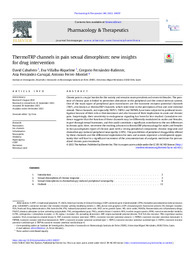Please use this identifier to cite or link to this item:
https://hdl.handle.net/11000/34358Full metadata record
| DC Field | Value | Language |
|---|---|---|
| dc.contributor.author | Cabañero, David | - |
| dc.contributor.author | Villalba Riquelme, Eva María | - |
| dc.contributor.author | Fernandez-Ballester, Gregorio | - |
| dc.contributor.author | Fernandez-Carvajal, Asia | - |
| dc.contributor.author | Ferrer-Montiel, Antonio | - |
| dc.contributor.other | Departamentos de la UMH::Bioquímica y Biología Molecular | es_ES |
| dc.date.accessioned | 2025-01-11T14:54:16Z | - |
| dc.date.available | 2025-01-11T14:54:16Z | - |
| dc.date.created | 2022 | - |
| dc.identifier.citation | Pharmacology & Therapeutics | es_ES |
| dc.identifier.issn | 1879-016X | - |
| dc.identifier.issn | 0163-7258 | - |
| dc.identifier.uri | https://hdl.handle.net/11000/34358 | - |
| dc.description.abstract | Chronic pain is a major burden for the society and remains more prevalent and severe in females. The pres ence of chronic pain is linked to persistent alterations in the peripheral and the central nervous system. One of the main types of peripheral pain transducers are the transient receptor potential channels (TRP), also known as thermoTRP channels, which intervene in the perception of hot and cold external stimuli. These channels, and especially TRPV1, TRPA1 and TRPM8, have been subjected to profound inves tigation because of their role as thermosensors and also because of their implication in acute and chronic pain. Surprisingly, their sensitivity to endogenous signaling has been far less studied. Cumulative evi dence suggests that the function of these channels may be differently modulated in males and females, in part through sexual hormones, and this could constitute a significant contributor to the sex differences in chronic pain. Here, we review the exciting advances in thermoTRP pharmacology for males and females in two paradigmatic types of chronic pain with a strong peripheral component: chronic migraine and chemotherapy-induced peripheral neuropathy (CIPN). The possibilities of peripheral druggability offered by these channels and the differential exploitation for men and women represent a development oppor tunity that will lead to a significant increment of the armamentarium of analgesic medicines for person alized chronic pain treatment. | es_ES |
| dc.format | application/pdf | es_ES |
| dc.format.extent | 18 | es_ES |
| dc.language.iso | eng | es_ES |
| dc.publisher | Elsevier | es_ES |
| dc.relation.ispartofseries | 240 | es_ES |
| dc.rights | info:eu-repo/semantics/openAccess | es_ES |
| dc.rights.uri | http://creativecommons.org/licenses/by-nc-nd/4.0/ | * |
| dc.subject | Nociceptors | es_ES |
| dc.subject | Ion channels | es_ES |
| dc.subject | Inflammation | es_ES |
| dc.subject | Neuropathic | es_ES |
| dc.subject | Allodynia | es_ES |
| dc.subject | Hyperalgesia | es_ES |
| dc.subject | CGRP | es_ES |
| dc.subject | Hormones | es_ES |
| dc.subject | Menstrual cycle | es_ES |
| dc.subject.other | CDU::5 - Ciencias puras y naturales::57 - Biología::577 - Bioquímica. Biología molecular. Biofísica | es_ES |
| dc.title | ThermoTRP channels in pain sexual dimorphism: new insights for drug intervention | es_ES |
| dc.type | info:eu-repo/semantics/article | es_ES |
| dc.relation.publisherversion | https://doi.org/10.1016/j.pharmthera.2022.108297 | es_ES |

View/Open:
6-Pharmacology and Therapeutics 2022.pdf
674,37 kB
Adobe PDF
Share:
.png)
